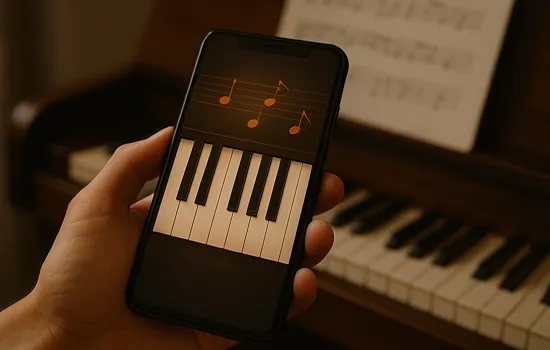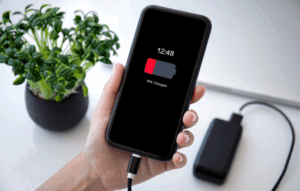Advertisements
Strategies to get the most out of your piano app
Before getting into practical recommendations, it's helpful to understand why these strategies will make a difference in your learning.
Advertisements
By applying a conscious approach—one that combines clear goals, consistent habits, and intelligent use of the app's features—you'll transform each session into a measurable step toward your musical goal. So, let's look at how to get the most out of your piano app.
- Define SMART goals
- Specific: learn “Für Elise” up to measure 30.
- Measurable: play at 80 bpm without mistakes.
- Achievable: one more level per week.
- Relevant: piece you always wanted to play.
- Temporary: within one month.
- Create study rituals
Set a fixed schedule: for example, 20 minutes after dinner. This habit will reinforce your discipline. - Divide and conquer
Break a piece into four-bar sections; practice separate hands before putting them together. - Record yourself on video
Don't rely solely on the app. Analyzing your posture and movements will help you avoid tension and bad habits. - Mixes technical practice and fun
Combine scales and arpeggios (mechanics) with songs you like (motivation). - Participate in online challenges
Almost all apps offer monthly challenges. Sharing your progress gives you accountability and external feedback. - Adjust the microphone sensitivity
If the app doesn't recognize some notes, increase the keyboard volume or connect via MIDI.
Advertisements
See also
- Radio Amador App
- Radio app on cell phone
- 5 natural foods to regulate blood sugar
- Turn your phone into a DJ mixer with these apps
- Monitor WhatsApp and Track Your Child's Cell Phone
Common mistakes when using piano apps and how to avoid them
| Mistake | Practical solution |
|---|---|
| Skip the theory and “just play songs” | Dedicate 10 minutes of each session to reading and chords; theory accelerates long-term learning. |
| Always practice at the same speed | Use the app's metronome: start slow, go up 5 bpm when playing clean. |
| Playing with tension in shoulders and wrists | Follow the posture videos; do some stretching before you begin. |
| Give up at the first recognition error | Adjust your mic sensitivity, play louder, or check your MIDI connection. |
| Not establishing a long-term plan | Use the app's calendar feature and set clear goals (e.g., official ABRSM exam). |
Frequently Asked Questions (FAQ)
Do I need an acoustic piano?
No. A 61- or 88-key digital keyboard is sufficient. Connecting via MIDI improves accuracy, but a microphone also works.
Can I learn on my own with the app without a teacher?
For beginner and intermediate levels, yes. If you aspire to become a professional, a human instructor will complement the app with advanced techniques and artistic expression.
Are subscriptions worth it?
If you practice at least 20 minutes a day, the investment is usually less than the cost of equivalent in-person classes.
Which app is best for young children?
Yousician, for its fun interface and quick rewards. Simply Piano also offers "Kids" courses.
Do the apps work offline?
Most require internet access to download lessons and submit statistics. Some offline features are available after saving.
Pricing plans and trial versions
- Simply Piano: 7-day free trial; annual subscription around $120, often discounted by 50% during seasonal sales.
- Piano Academy: Free basic content; monthly (~$13) or annual (~$80) Premium plan with full access to courses and sheet music.
- Yousician: Free plan limited to 10 minutes/day; Premium (~$180/year) with no restrictions; Premium+ (~$240/year) with a full catalog of commercially available songs.
Beyond the app: additional steps
- Get a sustain pedal
Even inexpensive keyboards support it; it will allow you to practice real articulations. - Print sheet music
Reading on paper will train your sight reading without relying on a screen. - Join local groups
Playing with other musicians—even online—improves your sense of timing and expression. - Mark milestones
Record a mini-recital every quarter; comparing old videos shows your real progress.

Conclusion: from mobile to stage
The dream of playing the piano no longer requires weekly commutes or prohibitive investments. With Simply Piano, Piano Academy and Yousician, you have virtual mentors capable of guiding you from your first step to advanced performances. These apps combine theory, guided practice, immediate feedback, and motivating communities, offering a complete ecosystem for anyone—child, teen, or adult—to learn music at the pace that best suits their life.
However, success depends on your perseverance: set realistic goals, practice regularly, and take advantage of every tool the app provides. Complement this with good study habits, proper posture, and, if you're passionate about going deeper, seek support from teachers or groups of musicians with similar interests.
With discipline and enthusiasm, your smartphone can become your best ally in mastering the piano. Download the app that best resonates with your goals, set up a practice plan, and let each note draw you closer to the extraordinary world of music. The stage is set; all you need to do is take a seat and start playing!




